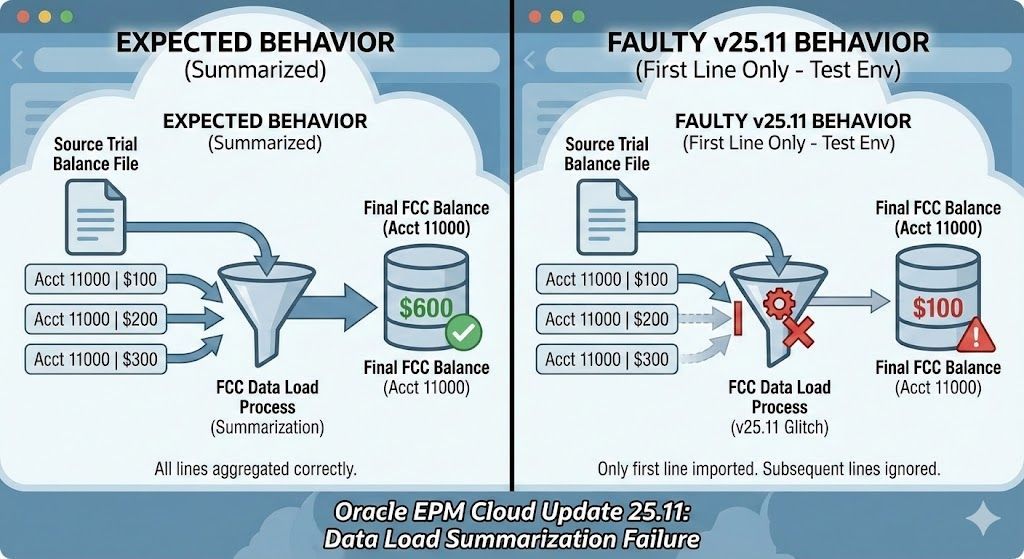Unlocking Seamless Tax Reporting: The Power of Oracle FCCS and TRC Alignment
Nadia Lodroman | Oracle EPM Consultant | Integrity in Every Insight.
Listen to Tresora and Ledgeron's chatting about this blog post:
How FCCS and TRC's Shared DNA Simplifies Tax Compliance

In today's complex financial landscape, businesses strive for efficiency and accuracy across all reporting functions. Oracle's Tax Reporting Cloud (TRC) and Financial Consolidation and Close Cloud (FCCS) are powerful tools designed to streamline these processes. A key advantage of these applications lies in their inherent alignment, particularly in the chart of accounts structure. This alignment facilitates seamless data flow and empowers organisations to achieve robust tax reporting. Let's delve into how this integration works and why it matters.
The Foundation: FCCS and the Mirrored Account Structure in TRC
When you deploy TRC, Oracle automatically creates a set of foundational structures, most notably the `FCCS_Balance Sheet` and `FCCS_Income Statement` account dimensions. This is no mere coincidence. These structures are designed to mirror the `FCCS_Account` dimension found within FCCS. This replication is crucial for several reasons:
- Consistency: By maintaining a consistent account structure, organisations ensure that financial data flows smoothly between consolidation and tax reporting.
- Reduced Reconciliation: The alignment minimises the need for manual reconciliation between FCCS and TRC, saving time and reducing the risk of errors.
- Enhanced Auditability: A unified account structure provides a clear and auditable trail of financial data.
Essentially, Oracle lays the groundwork for seamless integration by ensuring that the core financial building blocks are identical in both applications.
The Engine: TRC_Tax Accounts and Tax Automation Rules
While the FCCS-derived structures provide the foundation, the real magic happens within the `TRC_Tax Accounts` dimension. This dimension is specifically designed to capture and manage tax-related data. Here's where tax automation rules come into play:
- Data Population: Tax automation rules act as the "vehicle" for moving accounting data from the `FCCS_Balance Sheet` and `FCCS_Income Statement` structures into the appropriate `TRC_Tax Accounts`.
- Tax Schedule Mapping: These rules map financial data to specific tax schedules, ensuring that the information is correctly categorised and presented for tax reporting purposes.
- Calculations and Adjustments: Automation rules can also perform calculations and adjustments, such as deferred tax calculations or adjustments for permanent differences.
- Efficiency and Accuracy: By automating the data flow and calculations, organisations significantly reduce the manual effort involved in tax reporting, while also minimising the risk of errors.
How it Works: The Data Flow
Imagine this scenario:
- FCCS consolidates financial data, populating the `FCCS_Balance Sheet` and `FCCS_Income Statement` accounts.
- TRC, with its mirrored structures, already has these accounts available.
- Tax automation rules are configured to extract relevant data from the FCCS-derived accounts and populate the corresponding `TRC_Tax Accounts`.
- These rules then apply the necessary tax calculations and adjustments, preparing the data for tax reporting.
This streamlined process ensures that tax reporting is based on accurate and consistent financial data, directly from the consolidated financial statements.
The Benefits:
Faster Reporting Cycles: Automation reduces the time required to prepare tax reports.
Improved Accuracy: Automated calculations and data flow minimise the risk of human error.
Enhanced Compliance: Consistent and auditable data ensures compliance with tax regulations.
Greater Visibility: A unified view of financial and tax data provides valuable insights for decision-making.
Conclusion:
The inherent alignment between FCCS and TRC, particularly in the chart of accounts structure, is a paradigm shift for tax reporting. By leveraging this integration and utilising tax automation rules, organisations can achieve significant improvements in efficiency, accuracy, and compliance. Oracle has designed these products to work together, and taking advantage of the built in connections will greatly improve the user experience, and provide correct and auditable data.
Turning financial complexity into operational clarity. Because in Finance, Integrity is Permanent.






